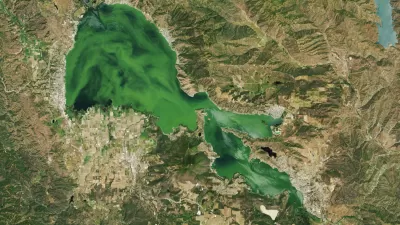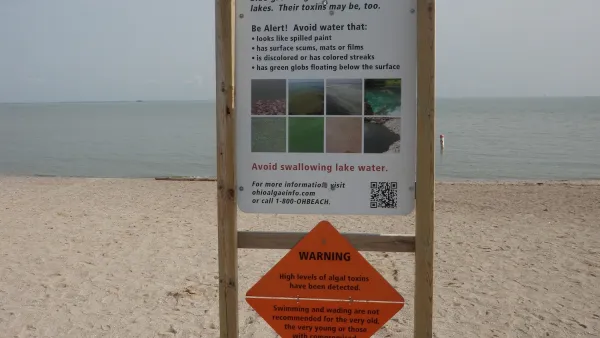Scientists hope to use AI and machine learning models to forecast water quality issues caused by toxic blue-green algae blooms.

According to the Los Alamos Reporter, scientists from the Los Alamos National Laboratory plan to use artificial intelligence modeling to forecast toxic algal blooms, which “[f]ueled by climate change and rising water temperatures … have grown in intensity and frequency” and “have now been reported in all 50 U.S. states.” Perhaps the most well-known occurrence of these harmful algal blooms, or HABs, happened in 2014, when dangerous toxin levels in Lake Erie forced Toledo, Ohio, to shut down the drinking water supply of a half-million residents for three days. Just last month, Clear Lake in California was in the news for its own blue-green algal bloom, which some fear will impact summer tourism activities.
“For decades, scientists have understood that elevated water temperatures, combined with sudden infusions of nutrients (often phosphorous and nitrogen runoff from industrial farming), tend to precede a HAB event …. But what causes toxic cyanobacteria to prevail in these freshwater ecosystems has proved challenging to understand” because they are “complex ecosystems influenced by hundreds — sometimes thousands — of other microorganisms,” the Los Alamos Reporter article reads. Armed with masses of data on HABs collected since 1954 by a variety of organizations across the nation and the world, the scientists plan to feed existing yet disparate information into a data learning model and use AI to decipher and analyze it.
“Such a model could then be used to forecast algal blooms, and possibly even predict how climate change will alter their intensity and frequency in the future,” said Babetta Marrone, senior scientist at the LANL and the project’s team lead, in a press release.
FULL STORY: LANL: AI Can Help Forecast Toxic ‘Blue-Green Tides’

Planetizen Federal Action Tracker
A weekly monitor of how Trump’s orders and actions are impacting planners and planning in America.

Congressman Proposes Bill to Rename DC Metro “Trump Train”
The Make Autorail Great Again Act would withhold federal funding to the system until the Washington Metropolitan Area Transit Authority (WMATA), rebrands as the Washington Metropolitan Authority for Greater Access (WMAGA).

The Simple Legislative Tool Transforming Vacant Downtowns
In California, Michigan and Georgia, an easy win is bringing dollars — and delight — back to city centers.

The States Losing Rural Delivery Rooms at an Alarming Pace
In some states, as few as 9% of rural hospitals still deliver babies. As a result, rising pre-term births, no adequate pre-term care and "harrowing" close calls are a growing reality.

The Small South Asian Republic Going all in on EVs
Thanks to one simple policy change less than five years ago, 65% of new cars in this Himalayan country are now electric.

DC Backpedals on Bike Lane Protection, Swaps Barriers for Paint
Citing aesthetic concerns, the city is removing the concrete barriers and flexposts that once separated Arizona Avenue cyclists from motor vehicles.
Urban Design for Planners 1: Software Tools
This six-course series explores essential urban design concepts using open source software and equips planners with the tools they need to participate fully in the urban design process.
Planning for Universal Design
Learn the tools for implementing Universal Design in planning regulations.
Smith Gee Studio
City of Charlotte
City of Camden Redevelopment Agency
City of Astoria
Transportation Research & Education Center (TREC) at Portland State University
US High Speed Rail Association
City of Camden Redevelopment Agency
Municipality of Princeton (NJ)





























